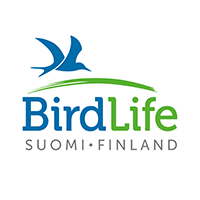Ultraviolet film reduces bird–glass collision risk
DOI:
https://doi.org/10.51812/of.115995Avainsanat:
ultraviolet vision, bird-glass collision, birds, anthropogenic hazardsAbstrakti
It is estimated that millions of birds globally die due to collisions with glass surfaces. In order to reduce this mortality, it is essential to provide an objective assessment of the effectiveness of bird-friendly preventive methods. Several types of opaque films and stickers are available nowadays and can be highly effective in protecting birds from fatal collisions. However, by being visible to the human eye, they can affect the users’ quality of view from within protected spaces. Products that take advantage of the birds' ability to see ultraviolet light seem to offset these impediments. This study determines if UV-reflective BirdShades film prevents birds from collisions with glass in natural environmental conditions. We monitored eight glass bus stops, where we had previously recorded high numbers of birds collisions. On four of them, we applied UV film, and the other four bus stops were used as control. A generalized additive mixed model showed a significant interaction between time (before vs. after) and film UV treatment (control vs. treated). Before the treatment, the number of collisions tended to be higher at treated bus shelters than control. However, this significantly changed after the treatment, suggesting that UV film reduces bird glass collision rate over 5-fold. Our study is the first worldwide that tested UV film on glass shelters and supports a conclusion that the UV film efficiently reduces the risk of bird collision.
Lähdeviitteet
Aidala, Z., Huynen, L., Brennan, P.L.R., Musser, J., Fidler, A., Chong, N., Machovsky Capuska, G.E., Anderson, M.G., Talaba, A., Lambert, D. & Hauber, M.E. 2012: Ultraviolet visual sensitivity in three avian lineages: paleognaths, parrots, and passerines. — Journal of Comparative Physiology A 198: 495–510. https://doi.org/10.1007/s00359-012-0724-3
Basilio, L.G., Moreno, D.J., Piratelli, A.J., 2020: Main causes of bird-window collisions: a review. — Annals of the Brazilian Academy of Sciences 92: e20180745. https://doi.org/10.1590/0001-3765202020180745
Bennett, A.T.D. & Cuthill, I.C. 1994: Ultraviolet vision in birds: what is its function? — Vision Research 34: 1471–1478. https://doi.org/10.1016/0042-6989(94)90149-X
Goldsmith, T.H. & Butler, B.K. 2005: Color vision of the budgerigar (Melopsittacus undulatus): hue matches, tetrachromacy, and intensity discrimination. — Journal of Comparative Physiology A: Neuroethology, Sensory, Neural, and Behavioral Physiology 191: 933–951. https://doi.org/10.1007/s00359-005-0024-2
Hart, N.S. 2001: The visual ecology of avian photoreceptors. — Progress in Retinal and Eye Research 20(5): 675–703. https://doi.org/10.1016/S1350-9462(01)00009-X
Håstad, O. & Ödeen, A. 2014: A vision physiological estimation of ultraviolet window marking visibility to birds. — PeerJ 2: e621. https://doi.org/10.7717/peerj.621
Hunt, S., Bennett, A.T.D., Cuthill, I.C. & Griffith, R. 1998: Blue Tits are ultraviolet tits. — Proceedings of Royal Society of London, Series B 265:451–455. https://doi.org/10.1098/rspb.1998.0316
Klem, D. Jr. 2009: Preventing bird-window collisions. — Wilson Journal of Ornithology 121: 314–321. https://doi.org/10.1676/08-118.1
Klem, D. Jr. 2014: Landscape, legal, and biodiversity threats that windows pose to birds: A review of an important conservation issue. — Landscape 3: 351–361. https://doi.org/10.3390/land3010351
Klem, D.Jr. & Saenger, P.G. 2013: Evaluating the effectiveness of select visual signals to prevent bird–window collisions. — Wilson Journal
of Ornithology 125: 406–411. https://doi.org/10.1676/12-106.1
Lind, O., Mitkus, M., Olsson, P. & Kelber, A. 2013: Ultraviolet sensitivity and colour vision in raptor foraging. — Journal of Experimental
Biology 216: 1819–1826. https://doi.org/10.1242/jeb.082834
Loss, S.R., Will, T., Loss, S.S. & Marra, P.P. 2014: Bird-building collisions in the United States: Estimates of annual mortality and species
vulnerability. — The Condor 116: 8–23. https://doi.org/10.1650/CONDOR-13-090.1
Machtans, C.S. & Thogmartin, W.E. 2014: Understanding the value of imperfect science from national estimates of bird mortality from window collisions. — The Condor 116: 3–7. https://doi.org/10.1650/CONDOR-13-134.1
Ödeen, A., Håstad, O. & Alström, P. 2011: Evolution of ultraviolet vision in the largest avian radiation - the passerines. — BMC Evolutionary Biology 11: 313. https://doi.org/10.1186/1471-2148-11-313
Ribeiro, B.C. & Piratelli, A.J. 2020: Circular-shaped decals prevent bird-window collisions. — Ornithology Research 28: 69–73. https://doi.org/10.1007/s43388-020-00007-0
Rössler, M., Nemeth, E. & Bruckner, A. 2015: Glass pane markings to prevent bird-window collisions: less can be more. — Biologia 70: 535–541. https://doi.org/10.1515/biolog-2015-0057
Sheppard, C.D. 2019: Evaluating the relative effectiveness of patterns on glass as deterrents of bird collisions with glass. — Global Ecology and Conservation 20: e00795. https://doi.org/10.1016/j.gecco.2019.e00795
Swaddle, J.P., Emerson, L.C., Thady, R.G. & Boycott, T.J. 2020: Ultraviolet-reflective film applied to windows reduces the likelihood of collisions for two species of songbird. — PeerJ 8: e9926. https://doi.org/10.7717/peerj.9926
Wood, S.N. 2017: Generalized Additive Models: An Introduction with R (2nd ed.). — Chapman and Hall/CRC. https://doi.org/10.1201/9781420010404
Zyśk-Gorczyńska, E., Skórka, P. & Żmihorski, M. 2020: Graffiti saves birds: A year-round pattern of bird collisions with glass bus shelters. — Landscape and Urban Planning 193: 103680. https://doi.org/10.1016/j.landurbplan.2019.103680
Zyśk-Gorczyńska, E., Sztwiertnia, H., Pietkieiwcz, M., Kolanek, A., Bojarska, K. & Żmihorski, M. 2021a: Local bird densities and habitats are poor predictors of bird collision with glass bus shelters. — Landscape and Urban Planning 217: 104285. https://doi.org/10.1016/j.landurbplan.2021.104285
Zyśk-Gorczyńska, E., Bojarska, K. & Żmihorski, M. 2021b: Nonrandom Bird-Glass Collision Pattern: Fewer Strikes Near Glass Edge. — Acta Ornithologica 56: 133–137. https://doi.org/10.3161/00016454AO2021.56.1.012
Żmihorski, M., Kotowska, D. & Zyśk-Gorczyńska, E. 2021: Using citizen science to identify environmental correlates of bird-window collisions in Poland. — Science of the Total Environment 811(2): 152358. https://doi.org/10.1016/j.scitotenv.2021.152358
Tiedostolataukset
Lisätiedostot
Julkaistu
Versiot
- 2022-10-07 (2)
- 2022-09-24 (1)
Numero
Osasto
Lisenssi
Copyright (c) 2022 Ewa Zyśk-Gorczyńska, Michał Żmihorski

Tämä työ on lisensoitu Creative Commons Nimeä 4.0 Kansainvälinen Julkinen -lisenssillä.








